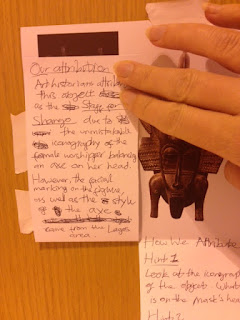Using a model borrowed from Lead Local, students then rated potential collaborators for the Global Museum, using criteria such as resource contribution, power/influence/ level of involvement, reliability, mission alignment, open mindset.
Next, students mapped the potential partners of the Global Museum, linking those partners working together and then identifying in different colors attributes of specific partners (influence, innovation, etc.).
The rainbow partners (partners identified as having numerous positive factors) for both groups included SFSU students and faculty, with the Art Department and local schools coming in next.
Spring 2016 MS 870 Blog
Sunday, April 10, 2016
The Santa Cruz MAH radical collaboration model
Using the honeycomb model from the Santa Cruz MAH, students worked to identify possible collaborators by highlighting specific audiences, assets, needs, collaborators and projects. For teachers, needs included: a place to let loose/relax; standards-aligned curriculum and activities; money and free resources. Assets identified included objects (object-based learning) and expert knowledge of standards. Collaborators identified included MS students (tours) and teachers, 3D printers, web designers, school site volunteers, photographers and SFSU students. Projects included loaning objects, digitizing collections and school tours.
For neighborhood schools, needs identified included: outside education; hands-on experiences; in-depth supplemental information. Assets included gallery space, knowledgeable staff and interactives. Collaborators identified included: various faculty; education department; youth; students; parents. Projects included on line presence; internships, school tours, curriculum and prototypes.
For neighborhood schools, needs identified included: outside education; hands-on experiences; in-depth supplemental information. Assets included gallery space, knowledgeable staff and interactives. Collaborators identified included: various faculty; education department; youth; students; parents. Projects included on line presence; internships, school tours, curriculum and prototypes.
Adventures in label writing
This interactive provided an opportunity for visitors to review, and select their favorite, from a range of labels written by diverse members of the campus community. For example, the Global Museum could ask an anthropologist to write a label for a specific object and an art historian. In this interactive, visitors could velcro their favorite label to the interactive, sharing what they view as the most compelling story.
Reverse attribution
In this detective-inspired interactive, visitors are encouraged to step into the role of a curator to determine the origin of objects in the Global Museum through object photographs and guiding questions. Visitors can test their knowledge by flipping up the object information with the attribution provided by Global Museum staff and students.
Connecting Africa
In this map-based interactive, students would look at a variety of images of masks in the collection of the Global Museum from throughout Africa--each mask illustrated at its point of origin on the map--making connections by using string to connect objects to each other.
Masks
This activity brings together masks from various cultures in the Global Museum, showcasing different uses of masks in different cultures, then providing a chance for visitors to create their own paper masks. Visitors would be encouraged to utilize meaningful symbols or forms in their own mask creation.
Deciphering Hieroglyphs
In this interactive, visitors could use hieroglyphic tiles to spell out their name, then record it with a rubbing on paper. Visitors could take home an activity sheet key for possible later post-visit activities.
Subscribe to:
Posts (Atom)

















